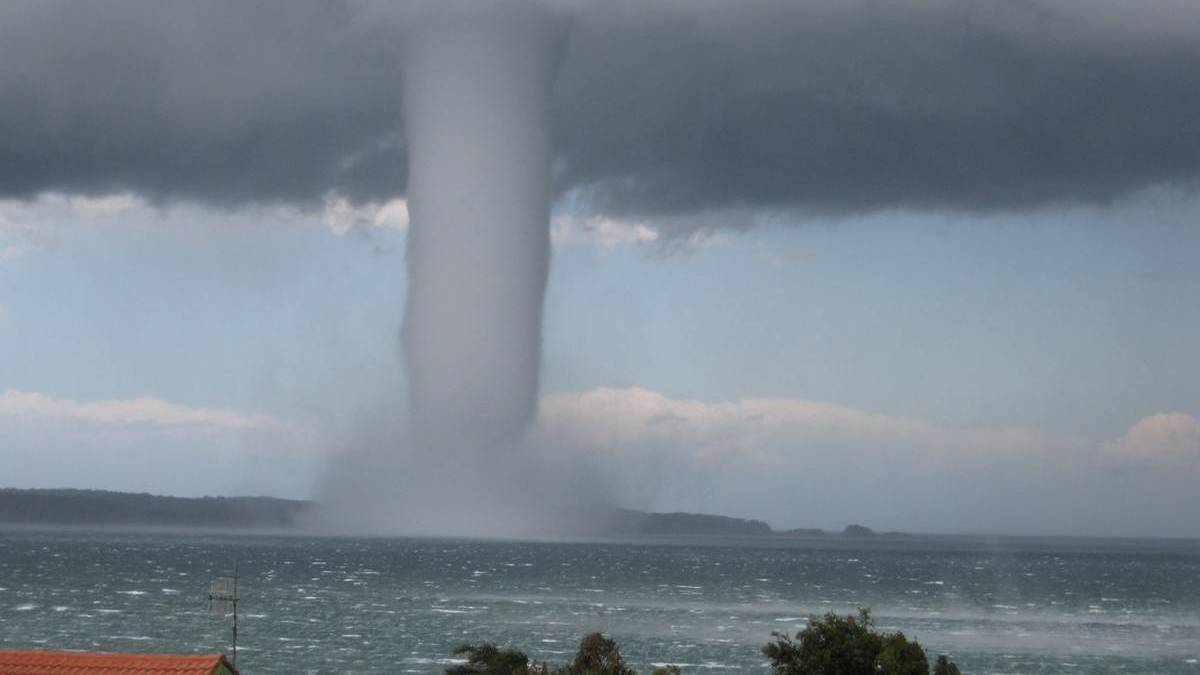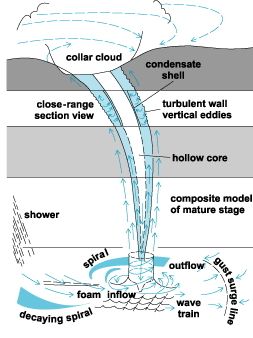
14 Jul Waterspouts
Waterspouts are some of the more iconic marine severe weather phenomenons as they have the ability to develop under any weather conditions as long as the localised environment is favourable for them, they have the ability to be quite large and quite small and they also have the ability to develop as families and move over land causing damage.
Waterspouts are considered to be part of the microscale of the weather world as the environment in general that they develop in can be extremely small (less than 2km) compared to thunderstorm and supercells which are much larger and cyclones which are even larger. They can develop under any circumstances as long as the environment is supportive of their development, so this means they can form from cumulus clouds, cumulonimbus thunderstorm clouds or supercell thunderstorms. The majority of waterspouts are weak by nature and produce damage that may not even rate on the Enhanced Fujita Scale (below EF-0). Some however can become tornadic and extremely dangerous. They typically develop in heavily saturated environments where low level shear is producing enough rotation for the vortex to develop. Its not considered uncommon for several waterspouts to occur simultaneously, unlike tornadoes. Lake Michigan currently holds the visual record of 9 occurring at once in a single photo, however more may have occurred at other times but not seen.

Quadruple waterspouts captured over the Adriatic Sea off Albania. Image via Robert Giudici in August 1999
Waterspouts have a distinct life cycle pattern which is unique to them and is constant for their existence. Firstly a prominent light coloured area appears on the surface of the water and this becomes surrounded by a much darker region. These coloured regions then begin to develop spirals on top of the surface of the water. Sea spray caused by the spirals and invisible tube then develop what can be loosely described as an eye. Eventually a funnel cloud will appear at the base of the cloud from which its originating and this funnel may connect with the activity occurring at the surface or it may remain “disconnected”. The final stage is when the vortex then weakens and begins to dissipate, normally the funnel will weaken first and then the spiral banding (basically in reverse order of how it developed).

Illustration of a waterspout lifecycle and structures
Waterspouts, as part of the tornado family, are the only “species” of the family that can be labelled as tornadic or non-tornadic. Dust devils are non-tornadic, tornadoes are obviously tornadic and landspouts are non-tornadic… if they were tornadic then they would be straight out tornadoes. Both types form under different circumstances.
-
Non-Tornadic: These waterspouts are not associated with a rotating mesocyclone / supercell thunderstorm. This is the most common type of waterspout and can often occur under fair weather conditions. This is also weaker of the two types. Florida Keys in the United States sees on average the most per year, with up to 400… however this type of waterspout is most common generally in tropical and sub-tropical climates. One of its features is that it moves quite slowly.

A large waterspout (non-tornadic) over the Florida Keys. Image via Dr. Joseph Golden in September 1969.
-
Tornadic: Yes, waterspouts are by definition tornadoes, but you can actually have a tornadic waterspout. This is one that develops with a mesocyclone present and can become very dangerous. Its essentially the same as a tornado over land… just its over water. This type of waterspout is much faster moving and can become a catastrophic danger to vessels or infrastructure out at sea. These types of waterspouts are more common through the Adriatic, Aegean and Ionian sea regions as the bulk of their thunderstorm and mesocyclone action occurs near the Coast or over open waters.

Waterspout spawned from a supercell (tornadic waterspout) observed off Sydney (during the Sydney to Hobart yacht race) in December 2001. Image via S. Golden
A common question is what can these things do to marine life. There have been many accounts across the globe where people have accurately recalled raining fish. The good thing for marine life is a waterspout will have to directly move over the top of it for any consequences to occur, the bad thing is though marine life often gets sucked up. Fish can become elevated in the clouds (not just in the vortex) and its not until the fish become too heavy for the updraft (kind of like hail) that they fall back down to Earth.. sometimes over landmass rather than water.



Sorry, the comment form is closed at this time.